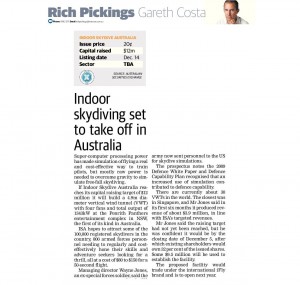Written by Gareth Costa
Super-computer processing power has made simulation of flying a real and cost-effective way to train pilots, but mostly raw power is needed to overcome gravity to simulate free-fall skydiving.
If Indoor Skydive Australia reaches its capital raising target of $12 million it will build a 4.9m diameter vertical wind tunnel (VWT) with four fans and total output of 1343kW at the Penrith Panthers entertainment complex in NSW, the first of its kind in Australia. ISA hopes to attract some of the 100,000 registered skydivers in the country, 800 armed forces personnel needing to regularly and cost-effectively hone their skills and adventure seekers looking for a thrill, all at a cost of $80 to $150 for a 50-second flight.
Managing director Wayne Jones, an ex-special forces soldier, said the army now sent personnel to the US for skydive simulations. The prospectus notes the 2009 Defence White Paper and Defence Capability plan recognised that an increased use of simulation contributed to defence capability.
There are currently about 30 VWTs in the world. The closest was in Singapore, and Mr Jones said in its first six months it produced revenue of about $3.9 million, in line with ISA’s targeted revenues. Mr Jones said the raising target had not yet been reached, but he was confident it would be by the closing date of December 5, after which existing shareholders would own 32 per cent of the issued shares. Some $9.5 million will be used to establish the facility. The proposed facility would trade under the international iFly brand and is to open next year.

